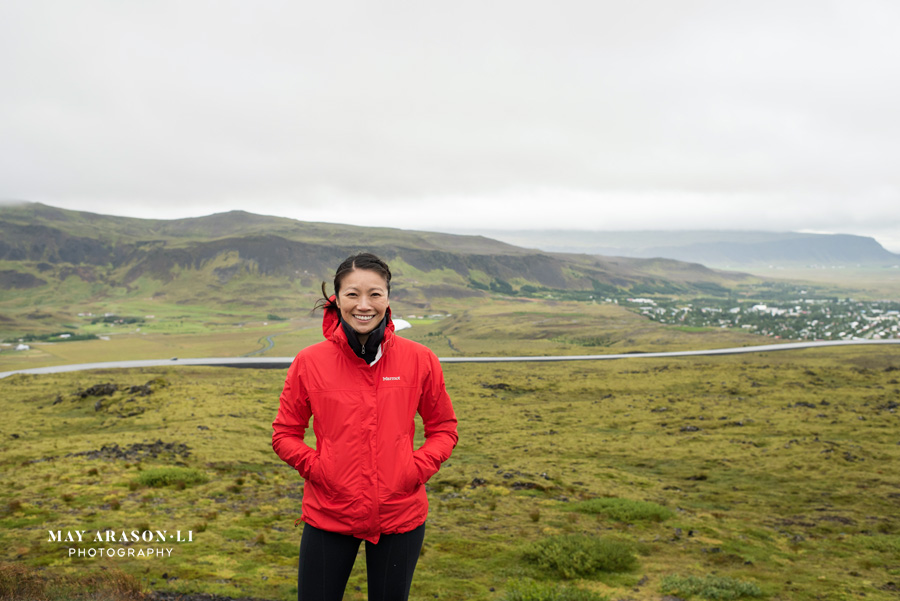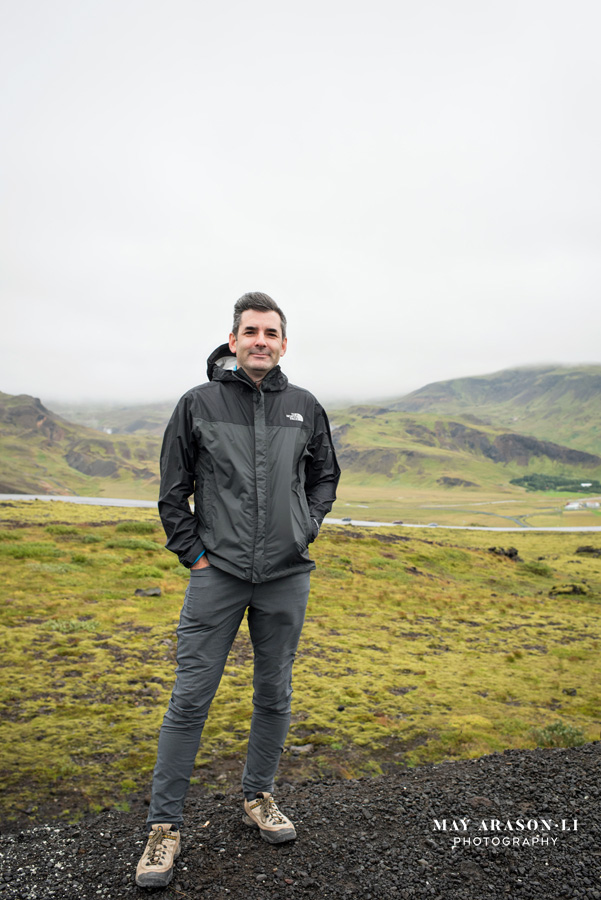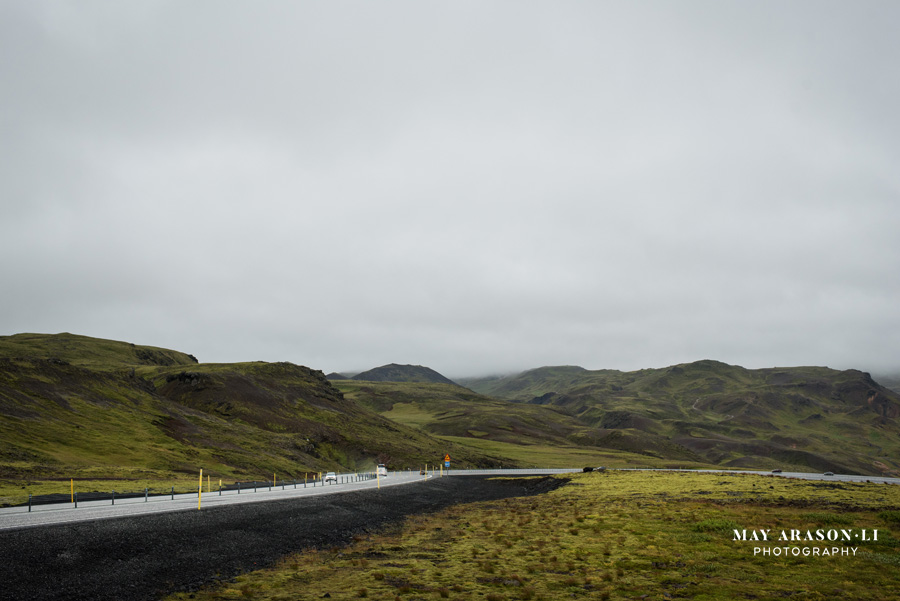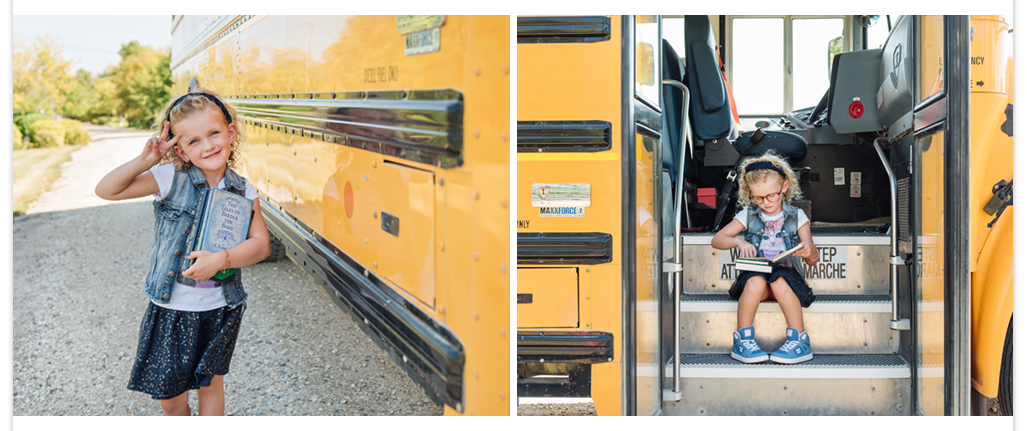“There’s no time to be bored in a world as beautiful as this.” I believe this to be true.
We visited the beautiful country of Iceland in August (2016). It all started as a lunchtime discussion amongst my running friends, almost two years prior, the idea to run the Reykjavik half marathon and an opportunity to visit a country on my travel bucket list. Almost a year and half later, the group’s plans for the year changed and that left just Cade and I to travel overseas on our own. It was a trip we had anticipated for so long that I didn’t dare tell many people for fear of jinxing our chance to go. Aside from its diverse and magical landscape, we had another reason to visit. Cade’s Great-great grandpa Skafti Arason was one several hundred Icelanders that sailed to Canada direct from Iceland in 1874. He would be amongst the small group of Icelanders to first settle in and establish the area now called Gimli. Being the first of the family to voyage back to the homeland had significant meaning to all of us.
I am not much of a writer so I would much rather let the (many) photos do the talking. One thing I will say is that you don’t go all the way to Iceland to stay indoors – it is definitely a country for those who love nature and want to be outdoors and take in all the natural beauty the country has to offer. When we were not in the car (because you do need one to get around), or eating and sleeping, we were always outside. One of the biggest reasons we wanted to visit Iceland was because of its diverse landscape, from waterfalls to moss covered lava fields to hot springs to glacial lagoons, it never ceased to amaze me. It is any traveller, outdoor enthusiast, nature lover, adventurer, photographer’s – heck, anyone’s dream come true to visit Iceland. In this country, we always felt safe and we were never concerned about our belongings. Even in the height of tourist season, we never really felt crowded, and driving on the highway was very easy and what surprised me the most was how courteous all the drivers are once they hit the road in Iceland. And in Iceland, everyone was extremely friendly and spoke English so communicaton was a breeze. I can honestly say that I fell head over heels in love with this country – and to this day, I still think about returning.
As we didn’t know when we might have the chance to see Iceland again, we decided to drive around the country on the ring road, with extra daylight hours and ice-free roads on our side. We started by heading around Iceland, in counter-clockwise direction, naturally. So sit back, relax. Grab a good beverage and enjoy. This will take some time.



Horses. I have to talk about the horses. The Icelandic horses are long-lived and hardy animals – and they are also very friendly and curious. We stopped many times to visit with them whenever we could – they happily chomped on the grasses we pulled and handed to them. Today, there are approximately 80 000 horses in a country of 300 000 people. The horse is a favourite among Icelanders and travelers alike as they are good tempered, versatile and beautiful. It’s the most colorful breed in the world with over 40 different colours.






Waterfalls. We saw waterfall after waterfall during our time in Iceland – and yet, we didn’t see nearly quite that many that Iceland has to offer. If you were to count every one of them, even the small ones, there would be thousands. We saw some of the most significant and accessible ones during our trip, but eventually, we lost count of the amount of waterfalls we saw each day. They literally dot the countryside – there are constantly new ones created from glacial melt. At one time, I counted twelve waterfalls in my line of sight.
One of the most beautiful and sought after waterfall by visitors is of course, Seljalandsfoss. This waterfall is some sixty meters high but the most fun part is that you can walk behind it – rain gear is absolutely recommended. While here, we also visited Gljúfrabúi, which is partially masked by its own canyon.














On my list of things to do in the South was to seek out a hidden pool called Seljavallalaug (e. Seljvavellir pool) deep in the valley. So off we went, in the rain. The pool is nestled in a narrow valley below the infamous Eyjafjallajökull (glacier) and it is the oldest pool in Iceland that is still standing. It was built in 1923 by some visionaries that wanted to provide the locals with a place where they could learn how to swim. There is nothing else around this pool but streams, waterfalls, mountains and lava. It is supposed to take about 20 minutes from the main parking area; however, it took us a lot longer due to the rain and the small “stream” (more like river) that we had to cross. The stream was fed by glacial waters and was painfully numbing. We forgot our flip flops in the car and we had to take off our socks and boots and roll up our pants to get across. We held hands as we crossed and stepped into the icy waters and onto jagged rocks. And as I was wincing in pain from the rocks and the cold water, I was thinking that this was probably where I would meet my demise as other people searching for the same pool gawked. But we made it and after that, we still had to walk for another ten minutes or so before we got sight of the pool. At which point, we changed out of wet gear and into swimsuits in a dark, wet change room amongst strangers, went for our obligatory swim in the spring fed pool that was surprisingly warm. Then got back into wet gear again and made the trek back to the car – and yes, across the icy river yet again. Exhausted yet? I am writing this now. By this time, we were going on pure adrenaline. There were still many stops to make before we would reach our guesthouse for the evening.








Skógarfoss – another spectacular waterfall in the South.



Dyrhólaey is a 120-metre high promontory, not far from Vík. The place got its name from the massive arch that the sea has eroded from the headland. It is home to hundreds of nesting puffins and sweeping views of the south coast, these seaside cliffs are easily accessible and incredibly impressive. After more driving in the rain and wondering if my camera gear was okay and also thinking we were out of luck to see puffins in mid-August, I was delighted to see a group of them on the side on the cliff, a mere 10 feet from us. I quickly ran back to the car to fetch my longer lens, grateful for having hauled it on the trip. The wind and drizzle continued – so much that we could not see very far beyond the cliffs and the sea was dark and angry looking.














Reynisfjara is beautiful black sand beach, under some of the country’s most beautiful basalt columns. The columns on the side of the Reynisfjall mountain were formed millions of years ago as seawater met basaltic lava and as the lava cooled, it left behind the amazing geometric columns and a beautiful cave. In the sea towards the nearby village of Vík, lie the dramatic looking sea stacks called Reynisdrangar. On the day we visited, the sea stacks were difficult to see but you can make them out in the photos. We didn’t get close to the water as the waves at Reynisfjara can be ferocious.














We were about to leave when I thought I had lost my lens cap on the beach (I know, good luck). When I got back, the lighting had changed – I had to take few more photos, of course. And it turned out my lens cap was safe in my bag the entire time.



It’s time I said something about the weather in Iceland. Rain in Iceland is inevitable – especially in the summer months. It greeted us at the airport and followed us around for the first four days of our trip but it was not enough to keep us from being outside. My only fear was my camera equipment might malfunction. And at the end of day two, after being on the go and out in the rain all day and into the evening, making it to our guesthouse quite late and having a very light dinner because everything was closed, I discovered that water had gotten into the LCD screen of my camera. Small panic attack. Thanks to the wifi capability of the camera body I was using, I downloaded an image from earlier in the day to my phone and confirmed it was perfectly fine. The camera housing was dry as a bone and the screen righted itself in the next couple of days despite being in the rain constantly. Note to self – invest in a real rain cover for the camera as plastic grocery bags, while they were cheap and readily available, couldn’t keep up with the rain in Iceland and I was constantly wiping the lens and screen every few seconds.
Kirkubæjarklaustur – Kirkjugólf (Church Floor), a natural pavement of basalt





Sheep – like waterfalls, dot the countryside. We definitely lost count of all the sheep we saw and marveled at where we would see them. On the sides of mountains, next to waterfalls, by the road, everywhere we went, we saw sheep.

Fjaðrárgljúfur is a magnificent and massive canyon, about 100 meters deep and about two kilometres long. The canyon has sheer walls, and is somewhat serpentine and narrow. It is believed that Fjaðrárgljúfur formed at the end of the last Ice Age, about nine thousand years ago. It is possible to walk at the bottom of the canyon – unfortunately, we were not able to do this it started to rain heavily, drenching us, and the walking paths were muddy and dangerously slippery.




By far, one of my favourite natural landscapes in Iceland were the moss covered lava fields. We affectionately called them the “mossy lumps” – the lava fields in this region were created in one of the most devastating eruptions in historic times, the Lakagígar eruption. The beautiful moss covers the largest lava field in Iceland and while it was tempting to test it out, the moss is far too delicate to be walked on by visitors. We could have stayed here a long time – I just loved the backdrop of green moss against dark skies and canyons.














Heading towards Skaftafell National Park, Skaftafellsjökull glacier in the background.

Svartifoss is one of the extraordinary waterfalls in South Iceland. It situated in Skaftafell, which belongs to Vatnajökull National park. It is a breathtaking waterfall, 12 meters high, with black columnar basalt formations which beautifully frame the waterfall and give it its name, Black fall. From afar it looks like a big heart. It was also Cade’s favourite waterfall.





Jokulsarlon glacier lagoon is right next to Vatnajökull glacier, Europe’s largest glacier. The lagoon is formed naturally, from melted glacial water coming from the glacier and is getting bigger each year, as big blocks of ice crumble from the ever decreasing glacier into the lagoon. We were fortunate that we booked tickets in advance to tour the glacial lagoon in advance – when we got there, we immediately got on a tour without having to wait. During our little cruise around the lagoon, we had the chance to eat a small piece of the ice and it was COLD!









The lagoon is connected to the sea on the other side of the road, the seawater also aiding to melt the ice from the glacier. The chunks of ice that fall into the lagoon slowly melt and drift out to sea, where the Atlantic waves crash on them at the black volcanic beach that’s found there.







Traversing along the East side of Iceland meant several stops to enjoy the magnificent views and sounds of the tranquil East fjords. One thing we noticed while driving around the country was that the landscape is unspoiled by signs all over the highway. No billboards, no signs telling you where the sites are every few kilometres. When you got to your site, you just knew.

















Reindeer are completely wild and can be spotted in Northeast Iceland. We actually saw a couple on our way up North along the Eastern coast.




Yes, more horses… it’s impossible not to stop and greet these beautiful creatures.






Heading North, we went through our first tunnel – Fáskrúðsfjarðargöng is 5.900 m (3.67 miles) long and it was rather nerve-wracking to go through such a long mountain pass.


Egilsstaðir is located on a large lake and home to the Icelandic version of the Loch Ness monster, the Wyrm, which has allegedly been spotted since Viking times. Here, we hiked to Hengifoss, Iceland’s second highest waterfall. On the way to Hengifoss, is another beautiful waterfall Litlanesfoss, with its graceful basalt columns. On this hike, and for the first time on this trip, we got our first glimpse of blue skies peeking through the clouds.






Hengifoss is surrounded by basaltic strata with thin, red layers of clay between the basaltic layers.





Snænautasel turf farmhouse is one of the homes, which had to be vacated when Askja caldera erupted back in 1875. It was not until 5 years later that people moved back into Sænautasel turf house. Since then it has been rebuilt a couple of times. It was recommended that we come here for some coffee and pancakes. We were greeted with some adorable wooly residents. We even met an Icelandic family traveling East who has been to Manitoba and Gimli several times!


Dettifoss is a waterfall in Vatnajökull National Park in Northeast Iceland, and is considered to be the most powerful and largest waterfall in Europe. The water comes from the nearby Vatnajökull glacier, whose sediment-rich runoff colors the water a greyish white. Here, we even caught a double rainbow. One thing about Iceland that is different from national parks in North America is that there is not a lot of barricades preventing you from getting closer to the edge. View at your own risk.




The smaller, but still pretty, Selfoss nearby.


Námaskarð earns its notoriety chiefly because of its sulphurous mud springs called solfataras and steam springs called fumaroles. And wow, was the sulphur smell ever strong!


Instead of Blue Lagoon, we opted to take a dip in the Myvatn Nature Baths, often referred to as the Blue Lagoon of the North.

Hverfjall has a large, circular explosion crater, about 140 metres deep and with a diameter of 1,000 metres. Hverfjall is one of Iceland’s most beautiful and symmetrical explosion craters, besides being one of the largest of its kind in the world.


A highlight of our trip up North was booking a whale watching trip in Husavik. Here, we did see a few Humpback whales and a pod of Pilot whales, which is not common this time of year, according to the guide.








Lone puffin leaving the island.






The Goðafoss stands for waterfall of the Gods. It was in the region of somewhere between Husavik and Goðafoss that we were close to the family’s ancestral homeland.





We passed through Akureyri, Iceland’s second largest urban area.






The waterfalls of Hraunfossar is best described as a collection of countless creeks and cascades small and big streaming out of the lava over a distance of about 900 metres.








Þingvellir (Thingvellir) National Park. The Þingvellir plain is situated on a tectonic-plate boundary where North America and Europe are tearing away from each other at a rate of 1mm to 18mm per year.








Geysir geothermal area – watching people’s reactions when Strokkur erupted (every 6-10 minutes) was most entertaining!






Iceland’s most famous waterfall, Gullfoss, is a spectacular double cascade dropping a dramatic 32m.





Kerið is a 6500-year-old explosion crater with vivid red and sienna earth and containing an ethereal green lake. Björk once performed a concert from a floating raft in the middle. Sadly, we did not see her on this trip.









Reykjavik – if you are still reading this and haven’t fallen asleep by now, you will know that we did spend time in country’s capital city. We spent two nights in fact, but not quite two full days. We stayed overnight when we first arrived and on our very last day, after returning from the Golden Circle area. After returning the car, that gave us the afternoon and evening to spend our last hours in the city before waking up very early again to catch our ride to the airport. We wished we had time to stay an extra day in the city but we got a good sense of it from the walking and eating, as well as the sites we saw. Reykjavik has a great vibe, with lots of great places to socialize, eat or have coffee. They are known for their street art and there are beautiful views from the harbour.































Harpa is the concert hall and conference centre in Reykjavík. The opening concert was held on May 4, 2011. The building features a distinctive colored glass facade inspired by the basalt landscape of Iceland.We spend a good amount of time in here – its unique architecture captured my heart the minute I set eyes on it. The angles, the shapes of the glass, everything about it was intriguing. So to end this post, I thought I’d share my favourites of Harpa.


























And last but not least, a collection of snaps from our phone cameras. We (okay I) took a lot of photos and had a difficult time culling them and narrowing down the ones for this post – there are even a few sites not included here. And being the photographer that I am, there are always images that I wish now I had also gotten but when you are there, you have to live in the moment. And weather, of course, plays a huge role in what you can and cannot shoot. Now all I can think about is when I can go back!









All I can say is, “WOW”! You did gave an awesome trip and now I can see why.
Oh. My. Goodness!!!! Best post ever! Just when I thought it couldn’t get more gorgeous, it did. Thanks so much for this. Gotta go!!!
Wow-great pictures May! You really captured the beauty of Iceland.
What an amazing trip!! Thanks for sharing your beautiful photos and memories with us!!
I love all of this! What an adventure! Thanks so much for sharing!
KELYL… LOL
Beautiful photos! I have always wanted to go there, and now I am even more inspired!
So nice. Most people can’t appreciate the beauty of a grey sky. You’ve made Iceland a place I’d like to visit, with a Pentax in tow. 😉 How great is it that Air Canada just announced that it will now fly there?!
Absolutely stunning photos May! It looks like a fairy tale world. It must have been an incredible journey.
These photos are out of this world amazing May! Looks like a National Geographic special. Really amazing pictures.
Loved your photos. You have inspired us to visit my grandparents homeland. Thank you for sharing.
Exceptional read, Positive website, where did u come up with
all the information on this posting? I have read a few of the posts on your
website now, and I really like your style.
Best regards,
Thomassen Henneberg